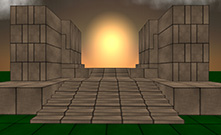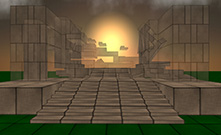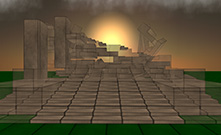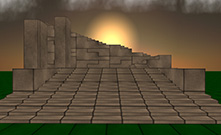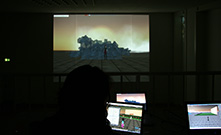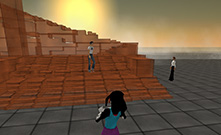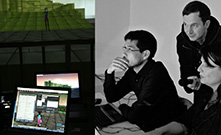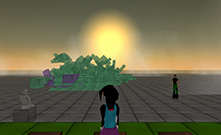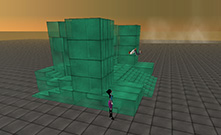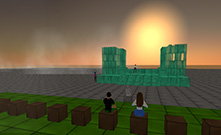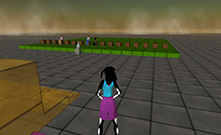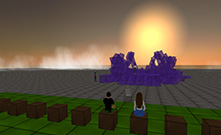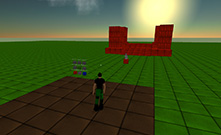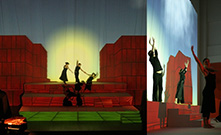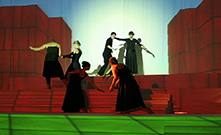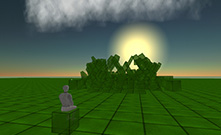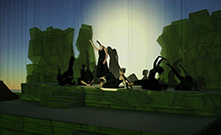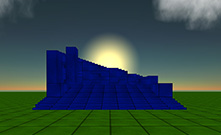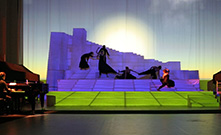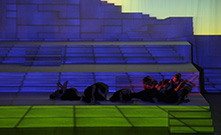Rhythmic Space(s)
v1.0 by: Michael Takeo Magruder with collaborators, 2007
A mixed-reality installation and performance environment based upon Adolphe Appia’s theories concerning space, time and movement.
About the Artwork:
In the early twentieth century, Adolphe Appia, a Swiss theorist and pioneer of modern theatre, sought to develop configurations of space, time and movement that would create a 'living' environment for performance. Rhythmic Space(s) explores evolutionary extensions of this work by reconsidering Appia’s original rhythmic space designs and eurhythmic performances that were first realised at the garden city of Hellerau between 1912 and 1913.
The artwork is based upon two of Appia’s stage designs, The Staircase - 1909 and Orpheus’ Descent into the Underworld - 1912, that have been translated into a hybrid articulated structure within the metaverse of Second Life. Existing in a state of constant flux, the resulting virtual environment is affected in real time by both avatar interactions and autonomous algorithms. These defined systems of control are blended with ambient environmental factors of the virtual world, such as light and wind, to create a living space for performance that is not under the sole domain of human intention.
Two distinct iterations of the work premiered in the Great Hall of Hellerau at the CyNetArt_07 festival. These realisations embraced both virtual and physical performance.
Performance Iteration I : Wind Dance
A Second Life performance for CyNetArt_07 realised in collaboration with the Association for Dance and Performance Telematics (ADaPT), Tokyo.
Working away on their laptops all afternoon, Michael Takeo Magruder prepared the public installation of his "Rhythmic Space(s)" project, to be unveiled in a [virtual/physical] performance ("Meeting Place(s)") on Sunday, and Ghislaine Boddington took it upon herself to develop the collaborative preparations that had been made all week between Magruder, myself, and the Tokyo team of the ADaPT network (Association for Dance and Performance Telematics). I had suggested to Yukihiko Yoshida and his teammates that it could be exciting to see them appear and perform spontaneously within the formally prepared stage setting (3D modelling) of Appia’s 'rhythmic spaces' within Second Life which Magruder had worked on for a considerable time.
Somehow I imagined it would be a fascinating counterpoint to have the live Hong Kong intervention performance by two artists from Slovenia followed by the performance avatar-aria created by Japanese artists within the German 3D model of Appia’s eurythmic Hellerau utopianism, computationally and artistically conceived by a Japanese artist and programmer working in London. In a sense, this is not a Weltbürgertum as much as it reflects the tremendous crossover trans-culturalism and trans-discipline creativity we see in the contemporary digital arts and sciences.
I will discuss the "Rhythmic Space(s)" project and "Meeting Place(s)" tomorrow, but end here with a lyrical echo of the late "Wind Dance" in Second Life.
Magruder had opened up his SIM territory in Second Life for a group of visitors (from the UK) and a group of performers (from Japan). Boddington then worked with Magruder and Yoshida on establishing the communications Saturday night and adapting the Japanese dancers to the 3D Appia environment and its orphic ambience, including the enormous sun emanating its glow at the horizon line. At around 22:40, just after Stromajer and Zorman had quietly vanished from the Hong Kong skyscraper, Gekitora appeared in the form of his avatar to enact his orphic-Icarus, whirling himself close to the sun and into the winds of the artificial world of Second Life.
The room where I watched this event (the Seitenbühne Ost) was completely silent. The "Wind Dance" solo happened in the quiet deadly eye of the storm of colour. Life on the re-imagined 3D digital planet Appia, the set of "Rhythmic Space(s)" - an apparition turning into a 20-minute tumbling flight, quietly repetitive but searing the mind, in its utter simplistic foreign machinimatic beauty, its utter uselessness, its extreme aesthetic purposefulness, its controlled spirited quality and anime-quality. This could not have been imagined in 1912 when Adolphe Appia did his sketches of the sun, and the light of spaces and cascading staircases, and when Dalcroze rehearsed with the dancers for the staging of Gluck’s "Orpheus and Eurydice". But we now watch such avatar presence and performance almost as if logical, as if consequential, even though it is not. Anti-gravity, and the fantastical potentialities of the metaverse, are mesmerizing concepts for dreams of flying in space or floating your viewpoint (POV). They do captivate our imagination, just as the old myths of Orpheus and Icarus did.
Reflection by Prof Johannes Birringer, CyNetArt_07 blog, 17/11/2007
Performance Iteration II : Meeting Place(s)
A virtual/physical performance for CyNetArt_07 realised in collaboration with the Hochschule für Musik Carl Maria von Weber, Dresden.
The performance took place in the great hall at 17:00 and again provided a unique historical moment whose significance one might not be aware of now - and what the future of such experiments will bring we don’t know at this point. But in the dance world, and in performance and music culture generally as well as in historical, archaeological and ethnographic research, the computer-assisted 3D modelling/visualization and recreation of material artefacts, sources and architectures is a technologically enabled science...
Here at Hellerau we witnessed an encounter of the third kind, a world premiere that is not easy to describe. The scientific and artistic research project derived from Magruder’s view of Appia’s original rhythmic space designs as conceptual explorations of space, not as illustrative plans for possible stage constructions. His reflection on Appia’s spatial theories coincided with King’s Visualization Lab’s start up of the Theatron 3.0 project, which began with the reconstruction of Hellerau in Second Life. The interdisciplinary nature of the project gathered together people with expertise ranging from theatre history and performance to advanced 3D modelling and scripting techniques. For the CyNetArt_07 premiere, the creative partnership also involved live performance realizations in Dresden composed by Prof Christine Straumer and seven rhythmic students of the Carl Maria von Weber Music Academy.
The local group of music/rhythm students - Florian Maser, Katarzyna Gorczynska, Thu Trang Nghiem, Elisabeth Lochmann, Ulrike Spörl, Stefanie Richter & Astrid Eisler - performed an improvised musical choreography inspired by Emile Jacques Dalcroze’s gestural sequences (plastique animée). These sequences were taken from his writings and sketches, not from of the 1912 production of Orpheus here at Hellerau (originally envisioned and realized inside the Adolphe Appia designs for rhythmic spaces), of which no scores or film footage survives, to my knowledge, although here it would be good to consult Richard Beacham (King’s College London), whose expert scholarship guided the project and whose seminal book on Appia paved the way for this partnership with Magruder and Drew Baker (3D modelling and programming)...
Speaking to the dancing musicians, I gathered that they were in fact inspired by the musical ideas their teacher, Christine Straumer, developed with them for finding movement material that corresponded to Appia’s drawings and sketches of rhythmicized light and space. The group developed three 'Bilder' (scenic pictures), which were named 'staircase', 'transformation', and 'orpheus'. These pictures corresponded to the "Rhythmic Space(s)" Magruder had built, and they also corresponded to different colours (red for Part I; blue for Part III; green-yellow for the 'transformation' representing the deformation and reformation of the digital space).
Straumer, in turn, improvised on the grand piano and created the improvisational musical sequences after the movement material had been found. Straumer sees her playing as live improvisation, and the music students perceive their dance in the same way, but they are fully conscious of the significance of the spatiality of Appia’s vision, the rhythms of space (terrains) and staircases. There are three levels of symmetrical heights (66 cm, 132 cm, 198 cm in height, 8 m in length, 3 m in width), and the scenographic environment was built at the tall end of the Hellerau Festpielhaus, with Magruder’s digital set (inside Second Life) projected onto the architecture.
So we were able to see the performance on the very location where the 1912 production of Orpheus was created, except that we are now in the real/renovated historical building with Appia’s set and scenography digitally created and projected by Magruder. But rather than using VRML or a game engine, Magruder’s 3D digital "Rhythmic Space(s)" metaversal environment has been transferred to a large SIM in Second Life.
The real musician-dancers performed their Dalcroze improvisation on the real and projected/virtual platforms and staircases of Magruder’s digitally re-elaborated Appia set in front of a sinking 'Appia' sun which is actually the atmospheric nature environment in Second Life, so I am told. The night before I sat quietly in the studio to watch Magruder work inside Second Life, and noted the slowly, subtly changing colours of the horizon, misty clouds drifting in the distance, surely, I thought, some kind of late night consensual hallucination caused by lack of sleep. Magruder here seems a kindred spirit to Olafur Eliasson, who’s "Weather Project" had a strong hyperrealist effect on our perception through the use of powerful, monochrome orange light. he welcomes the natural-artificial oscillations of light (daylight, sunlight, clouds drifting by, the mist in the distance…) in Second Life, and during the presentation he performed some uncanny manoeuvres to transmutate the Bilder (scenes) for the musician-dancers, as he was able to make the Appia 3D sets slowly disintegrate and change into different spaces of scenic-rhythmic lighting. A choreography of light and slow mutation, a mesmerizing thing without name.
Reflection by Prof Johannes Birringer, CyNetArt_07 blog, 18/11/2007
Experience Version 1.0:
CyNetArt_07 festival: 16-24 November 2007, (physical) Festspielhaus Hellerau, Dresden, DE and (virtual) Transitional Space, Second Life.
In Collaboration with:
Drew Baker [ SL modeling & programming ] . Prof Richard Beacham [ academic research ] . Yukito Obara (as 'Gekitora Gackt') and his colleagues from the Association for Dance and Performance Telematics, Tokyo, JP [ Wind Dance performance ] . Prof Christine Straumer and her students from the Hochschule für Musik Carl Maria von Weber, Dresden, DE [ Meeting Place(s) performance ]
With Thanks to:
Thomas Dumke (TMA Hellerau) [ funding & infrastructure ] . Ghislaine Boddington [ Wind Dance dramaturgy ] . Johannes Birringer [ theoretical analysis ]
Supported by:
Rhythmic Space(s) is a 2007 commission by Trans-Media-Akademie Hellerau for its CyNetArt_07 festival with additional support from King’s Visualisation Lab, Centre for Computing in the Humanities, King’s College London.
